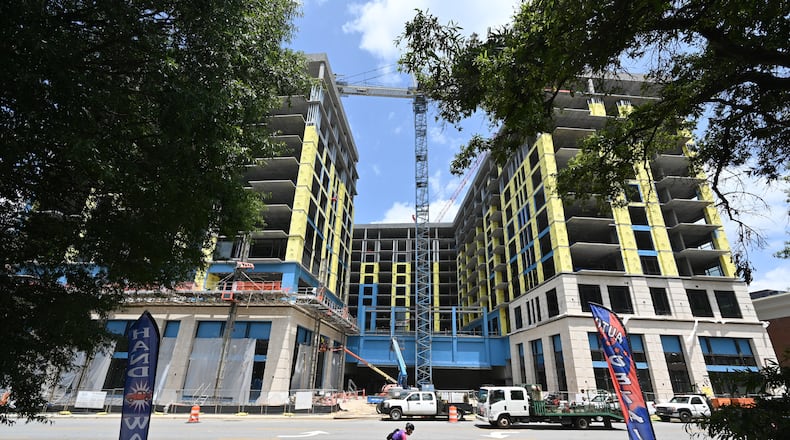The website for 99 West Paces says the 13-story apartment tower “is the comfortable side of Buckhead,” a nod — whether intentional or not — to the Tuxedo Park mansions, St. Regis Hotel and prestigious private schools and social clubs that line one of Atlanta’s wealthiest thoroughfares.
The high-rise will boast such premium amenities as a wellness center with yoga studio, a “resort-style pool” with private cabanas and 24-hour concierge service.
In June 2019, the Development Authority of Fulton County (DAFC) awarded developers of the luxury building an estimated $3.35 million tax break over 10 years. In exchange, the developer pledged “its best efforts” to reserve a few dozen units as “workforce housing” at rents affordable to households making $100,000 to $120,000 a year — double the wages most experts consider as eligible for subsidized workforce housing in metro Atlanta.
The Atlanta Journal-Constitution reviewed 99 West Paces and more than 80 projects granted tax breaks by DAFC. The AJC found they were overwhelmingly concentrated in fast-growing areas where market conditions were extremely favorable or came with few public benefits, raising questions about the need for taxpayer subsidies. The AJC also found many of the Fulton authority’s deals lowered the potential to raise tax money for completion of the Atlanta Beltline.
DAFC granted preliminary or final approval to more than $328 million in tax breaks to developers and major corporations since January 2018, the AJC’s analysis found. Intended to stimulate development that wouldn’t otherwise happen or recruit companies to Fulton, nearly three-quarters of those dollars were granted for projects north of I-20 in places such as Buckhead and Midtown and rapidly gentrifying areas along the length of the Beltline.
The Beltline as originally envisioned was supposed to generate much of its funding through the growth of future property tax revenue.
Though apartments, hotels and office buildings are sprouting like mushrooms there, the city recently levied a new tax on commercial properties and apartments within a half-mile of the 22-mile-long loop of parks and trails because new property taxes have fallen far short of projections.
The AJC analysis shows DAFC has granted more than $58 million in tax breaks for new projects on the Beltline since the beginning of 2018, long after the building boom started. That’s about three-fifths of the $100 million in bonds the city hopes to finance with its new taxes on businesses.
“You’re going to have a hard time convincing me or anyone else that Buckhead, Midtown or the Beltline need any help attracting deals,” said former Atlanta Public Schools Board Chairman Courtney English. “They’re some of the most attractive areas to live or do business in the country.”
The AJC found that DAFC’s internal operations incentivize the agency to cut deals. DAFC largely funds itself from the fees that it charges developers for the tax breaks it grants.
And the agency’s previous executive director, who earned a base salary of $250,000, had a bonus plan that paid him an extra 10% if the authority generated at least $2 million in fee revenue — a threshold the authority routinely eclipses.
I-20 is a rough line dividing whiter and wealthier northern Fulton from southern Fulton, which has a higher percentage of Black and poor households. North of that line, DAFC tends to support luxury apartments, gleaming mixed-use high-rises and high-dollar hotels. South of the freeway, the bulk of projects consist of warehouses and other industrial properties with low-wage jobs, the AJC found.
Credit: HYOSUB SHIN / AJC
Credit: HYOSUB SHIN / AJC
Nathan Jensen, a professor of government at the University of Texas at Austin who studies economic development strategies, reviewed the AJC’s findings, and said he was surprised by the scope of DAFC’s program.
The best incentive programs, he said, have defined goals and give targeted support to prime the pump in underserved areas, promote growth of specific industries or encourage companies to create jobs at higher than the median average wage.
The Fulton authority, Jensen said, seems to have incentivized nearly every type of high-demand development “in some of the most attractive areas of the state” with few minimum requirements for public benefits.
“To be honest, this looks so bad that people are either asleep at the wheel or people don’t care,” Jensen said. “You can’t say with a straight face that this is adding value to the community.”
Necessary incentives?
In recent months, reporting by the AJC revealed a culture of loose financial oversight at DAFC. Board members paid themselves per diems or stipends that county commissioners said may not have been legal.
Some were paid multiple per diems for official acts on the same day — or in the case of former Chairman Bob Shaw, for the number of tax breaks and other items under consideration by the authority’s board.
Current DAFC chairman and interim executive director Michel “Marty” Turpeau IV, whose board has tightened internal controls in recent months, told the AJC that the Atlanta region faces competition for projects from other locales. He said that incentives, even in hot markets, are essential to luring investments and growing the tax base.
(Story continues below map.)
Companies have choices of where to spend their investment dollars, and “internal thresholds they must meet” before deciding on projects, said Turpeau.
“Is it worth the risk of losing a project altogether for a small discount?” he said.
But the awards have come under increasing scrutiny by taxpayers who fear government officials dole out far more than the return in public benefits, pushing more of the overall tax burden on homeowners and other businesses.
A 2018 study by the Michigan-based W.E. Upjohn Institute for Employment Research found that local and state incentives rarely are the deciding factor in a company’s decision to locate or expand.
The study estimated that 75% to 98% of the time, a company granted incentives would have made the same choice without local or state subsidies.
“To be honest, this looks so bad that people are either asleep at the wheel or people don't care. You can't say with a straight face that this is adding value to the community."
A 1993 Fulton incentives policy once limited the use of DAFC’s tax breaks, known as tax abatements, to corporate relocations and expansions. It required a minimum of 250 jobs and $50 million in investment in north Fulton, and 150 jobs and $25 million in investment in southern Fulton. The standards for blighted areas were lower, but still required 90 jobs and $15 million in investment.
Over the years, DAFC, which called the policy “guidelines,” broadened the use of abatements to nearly every type of commercial real estate project — and ditched the job creation goals.
In 2018, the authority put in place a new standard. The finished project must increase the fair market value of a site — and thus its expected tax revenue — by five times after factoring in the value of the incentive, though that standard can be waived for “compelling community impacts,” a DAFC document says.
Invest Atlanta, the city’s development authority, has granted only seven tax breaks under a similar program in the past three years, totaling $36 million in tax savings. One project, the headquarters of Norfolk Southern, which promised 850 new jobs, made up about two-thirds of the total taxes abated.
In other deals, Invest Atlanta’s board required developers of projects to provide a higher level of affordable housing than what’s required by city code, or supported creation of middle wage jobs.
‘A development-entitlement program’
For years, Atlanta and Atlanta Public Schools have tried to limit or prevent DAFC from doing deals within their jurisdiction and which cut their tax revenue, to no avail.
Major concerns are that DAFC and Invest Atlanta end up competing against one another for deals and the fees they generate, and that developers can go to the authority with the loosest rules for subsidies.
Bill Bozarth, an Invest Atlanta board member, said when he joined the board he questioned why staff of the Atlanta agency would bring forward proposals in parts of the city that didn’t seem to need a boost.
“When I kept pressing the staff, ultimately the answer was, ‘Well, Bill, if we don’t provide the tax break, the Fulton County Development Authority will do so anyway,’” Bozarth said in a July 14 county commission meeting. “It’s become so commonplace, it’s almost like a development-entitlement program.”
About 72% of DAFC’s tax breaks were granted inside the city of Atlanta, the AJC analysis shows.
Using DAFC’s formula for collecting fees from developers, the AJC estimated that DAFC could earn about $9.3 million in fees from deals struck since 2018. Two-thirds of that could come from tax breaks inside the city limits of Atlanta.
Credit: HYOSUB SHIN / AJC
Credit: HYOSUB SHIN / AJC
Turpeau disputed this finding. He said DAFC gives fee discounts on some of the larger projects, meaning some deals in Atlanta provided less revenue to DAFC.
But, for an entity that has about $2 million per year in expenses, DAFC likely could not fully fund its operations without dipping into its reserves if it did not do deals in the city of Atlanta, the AJC analysis found.
Abatements cut funds for Beltline
On a recent Wednesday, joggers hit the Beltline’s eastside trail, running on a ribbon of sidewalk in a manmade canyon of high-end apartments.
Billions of dollars in new development have come to the Beltline since Atlanta Beltline Inc., its governing agency, bought the first segment of rail right-of-way in 2007.
But projections that property tax growth within the Beltline Tax Allocation District (TAD), private donations and other financing would pay for the project have fallen short. The Great Recession is partly to blame.
But so, too, are millions of dollars in tax abatements that have been approved since the intown property market has rebounded.
Since the beginning of 2018, DAFC has awarded about $58.2 million in tax breaks in the Beltline TAD. Invest Atlanta has also granted them in the Beltline TAD over the years.
Collectively, these breaks have depressed tax revenue for build out of the Beltline, critics say, including money that could be used for badly needed affordable housing.
In March, Atlanta City Council approved a new tax on commercial property and apartment buildings within a half-mile of the Beltline to raise additional revenue for the 22-mile trail. The tax will support $100 million in bonds, and take two to three decades to repay.
Turpeau said tax abatements stimulate affordable housing and strengthen the revenue potential of the TAD.
But one of the city’s justifications for the new taxes was the revenue loss from tax abatements.
A ripple effect on business
Craig Pendergrast, an Atlanta real estate attorney, chairs the Little Five Points Community Improvement District, whose members tax themselves to pay for improvements in the district.
Pendergrast said he sees a ripple effect from the tax abatements that hurt local businesses, and he questions if the Beltline would even need the new special services tax if fewer abatements had been granted.
He said commercial property owners in Little Five Points get little boost from the Beltline, but will pay extra taxes for the SSD, about $2,000 for every $1 million in assessed property value.
Property owners may pass those on to their tenants, he said, many of which are still struggling to rebound from business lost to the pandemic.
Credit: HYOSUB SHIN / AJC
Credit: HYOSUB SHIN / AJC
The business district generates about $30,000 per year in revenue from its members, barely enough, Pendergrast said, to fund a part-time executive director, insurance and incidentals. The district has so few resources that it must leverage other governments for help. It worked with the state for a new pedestrian crossing and bike lanes on Moreland Avenue, and the Atlanta Regional Commission for improvements to Euclid Avenue.
The district wants to grow its membership to tackle bigger projects like improving the interchange at Moreland and DeKalb avenues.
It’s a tough sell to ask businesses to tax themselves coming out of the pandemic on top of the new SSD and new trash and street frontage charges levied by the city, Pendergrast said.
“The Beltline SSD is making it harder for us to expand and provide services to our core district and otherwise,” he said.
Homeowners squeezed
Natallie Keiser, a senior associate with the Annie E. Casey Foundation who focuses on neighborhood transformation, said DAFC needs to make sure developers are actually helping communities when they get abatements.
“I don’t think that’s been happening,” she said.
Jennifer McIntosh, the chair for Neighborhood Planning Unit-L, which includes Vine City and English Avenue, said the high-end apartments and office space that have come to her neighborhood with the help of DAFC tax breaks will push residents like her out.
“I don’t think they should be doing those kinds of deals. It’s cutting us out, us little people,” she said. “They’re jacking up the prices and it’s hard for others to stay.”
McIntosh said she gets mailers three to four times a week from investors who want to buy her home near Mercedes-Benz Stadium, close to where the Rev. Martin Luther King Jr. and his family lived. Offers range from $200,000 to $700,000, she said.
Starved south of I-20
In a recent Fulton commission meeting, Turpeau and other DAFC board members said new leadership is focused on assisting underserved communities south of I-20.
English, the former school board chair who is running for Atlanta City Council president, said parts of Atlanta are starved for investment.
He said tax abatements could be directed to incentivizing developers to build in areas they otherwise wouldn’t, or attract community necessities such as quality grocery stores within food deserts.
“Campbellton Road is underserved and underdeveloped,” he said. “We can’t get a grocery store that people are happy with to save our lives.”
Credit: HYOSUB SHIN / AJC
Credit: HYOSUB SHIN / AJC
Since 2018, DAFC has granted tax breaks to at least three projects that promised grocery stores. None were in southwest Atlanta.
One will be part of the second phase of the Interlock, a mixed-use project in a gentrifying stretch of Northside Drive in Home Park, near Georgia Tech. Another is slated for a parcel along Ponce de Leon Avenue near Mary Mac’s Tea Room.
As for the third, discount grocer Lidl received a nearly $500,000 tax break to overhaul an aging retail center. The project is on Holcomb Bridge Road in Roswell.
Keep Reading
The Latest
Featured








